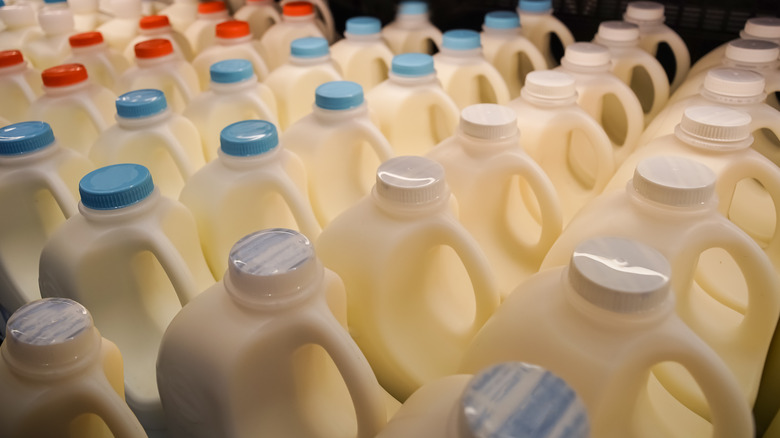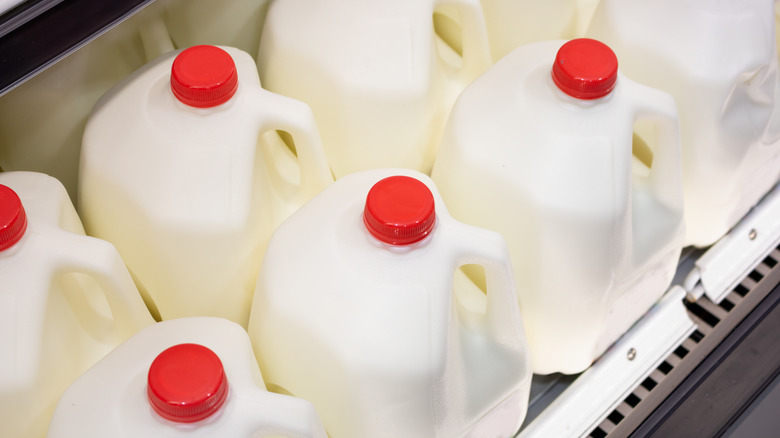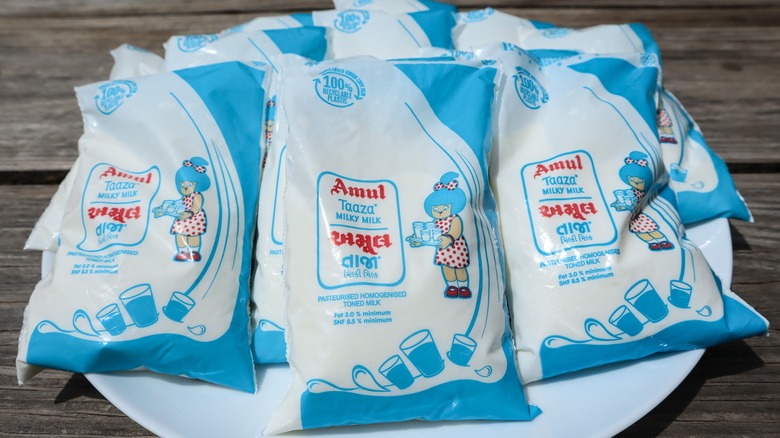Ever Wonder Why Plastic Milk Jugs Have Indents?
Perhaps you traced your finger around the circular indent on the milk jug at the dinner table as a child. Maybe you've never even noticed it. Or, perhaps you have but never gave it a second thought — milk jugs just have them, and they always have and probably always will. But what exactly is the purpose of that uniform round depression you find on the side, no matter its brand, volume size, or the percentage of fat on the inside?
Some people believe that the inverted dimple will pop out when the milk has spoiled because bacteria are present. While a plastic jug can and will bloat from gas buildup from microbes, this theory is actually false (though other factors, such as altitude changes or freezing the milk, can also cause expansion and swelling). Non-harmful bacteria can similarly cause containers to bulge out, while some spoilage pathogens may not — rendering it a flawed and ineffective design if that were the intention.
The main purpose of the indentation is to save money while not sacrificing aesthetics. Jug manufacturers were aiming to create a container that was stable and still looked good when filled with milk (i.e., no bulges). And from a business perspective, they wanted to use as little material as possible, as shaving off even just fractions of a millimeter can save serious dough on a mass production scale. The solution, per a patent from 1998, was to stamp a small circular indent into the plastic.
How the indent works
The indent helps stabilize the walls of the jug, which allows for less thickness, and therefore less material, to be used. It also keeps the jug always looking full to the top so customers won't be dissuaded from buying it. The result is dollars saved, earned, and happy milk drinkers.
When it comes to always looking full, the indent serves as a control mechanism during the filling process. The size of the plastic jug may change slightly with temperature, so the indents are purposely made a little bit larger to account for any shrinking during the warmer summer months, and slightly smaller during colder months. This prevents leakage and the jug from looking under-filled in certain temperatures. The ability to alter the size and depth of the indent allows for such fluctuations while ensuring customers are always getting the same amount of milk — and the manufacturer never needs to change the standard mold.
The indent also allows for flexibility in the plastic for pressure changes. If you've ever dropped a jug, you may have noticed that even a small dent in one side may have caused the indent to pop out a bit — that little circle probably saved you from possible tears shed over spilled milk, and a massive mess to mop up. In addition, while the circle doesn't expand to indicate spoilage, it does allow non-harmful bacteria to do their thing and maybe cause a little, um, bloating. Hey, bacteria have bodily functions, too.
Other fun facts about plastic milk containers
While the changeable volume indent came about in the late 1990s, plastic milk jugs have been on store shelves since the 1960s. The jug design is a classic, but that hasn't stopped manufacturers from attempts at innovation.
New designs have been tested over the years and met with mixed reviews. Square milk jug gallons came about circa 2008 in hopes of a shape better suited for stacking. Big box retailers like Costco and Sam's Club were quick to take up the trend and celebrated its lower cost and efficiency, but customers were not as satisfied with the flat-topped milk containers. The stores even went as far as holding in-person demonstrations of how to use the new containers as people couldn't get a handle (pun intended) on how to pour from the odd shape. As of 2023, Costco is believed to still be working on a solution that will make all parties happy.
Milk in plastic bags may seem a little counterintuitive, and possibly for good reason. Large amounts need to be transferred to a pitcher for pouring and proper milk storage in the fridge. While not as common to come across in the United States, Canada, Russia, and Argentina enjoy milk from a bag. Some states tried to adopt the trend but to no avail. It did stick for a bit with some schools in Omaha, however, who replaced small cartons for kids with little pouches with straws.



